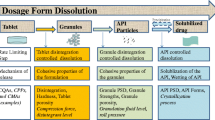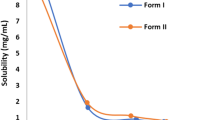Abstract
Principles of dissolution science have been applied to allow waiver of in vivo bioequivalence studies for oral immediate release solid dosage forms, providing certain stipulations are met. This approach reduces regulatory burden without sacrificing product quality and performance requirements that assure continuing equivalence. These principles are broadly applicable to other dosage forms and routes of administration. In this article, we postulate a further opportunity, which relies on a determination of “optimal performance” for nonsolution orally administered drug products. The determination can be applied to certain highly soluble and rapidly dissolving drug products without further study, paving the way possibly for even further reductions in regulatory burden.


Similar content being viewed by others
References
FDA Guidance for Industry. 1997. Dissolution testing of immediate release solid dosage forms. http://www.fda.gov/cder/guidance/index.htm. Accessed 14 Jan 2014.
FDA Guidance for Industry. 1997. Extended release dosage forms: development, evaluation and application of in vitro in vivo correlation. http://www.fda.gov/cder/guidance/index.htm Accessed 14 Jan 2014.
FDA Guidance for Industry. 2003. Bioavailability and bioequivalence studies for orally administered drug products. General considerations. http://www.fda.gov/cder/guidance/index.htm Accessed 14 Jan 2014.
FDA Guidance for Industry. 1995. SUPAC-IR. Immediate release solid oral dosage forms. Scale-Up and post approval changes. Chemistry, manufacturing and controls. In vitro dissolution testing and in vivo bioequivalence documentation. http://www.fda.gov/cder/guidance/index.htm. Accessed 14 Jan 2014.
FDA Guidance for Industry. 1997. SUPAC-MR. Modified release solid oral dosage forms. Scale-Up and post approval changes. Chemistry, manufacturing and controls. In vitro dissolution testing and in vivo bioequivalence documentation. http://www.fda.gov/cder/guidance/index.htm. Accessed 14 Jan 2014.
Amidon GL, Lennernas H, Shah VP, Crison JR. A theoretical basis for a biophrmaceutic drug classification system: the correlation of in vitro drug product dissolution and in vivo bioavailability. Pharm Res. 1995;12(3):413–20.
FDA Guidance for Industry. 2000. Waiver in vivo bioavailability and bioequivalence studies for immediate release solid oral dosage forms based on biopharmaceutics classification system. http://www.fda.gov/cder/guidance/index.htm. Accessed 14 Jan 2014.
WHO technical report series 937, Annex 7. Multisource (generic) pharmaceutical products. Guidance on registration requirements to establish interchangeability. Geneva, Switzerland. WHO, 2006. http://apps.who.int/prequal/info_general/documents/TRS937/WHO_TRS_937__annex7_eng.pdf. Accessed 14 Jan 2014.
USP MC <12>, United States Pharmacopeial Convention, Rockville, MD 20852.
SUPAC-SS. Nonsterile semisolid dosage forms. Scale-Up and post approval changes. Chemistry, manufacturing and controls. In vitro release testing and in vivo bioequivalence documentation. http://www.fda.gov/cder/guidance/index.htm. Accessed 14 Jan 2014.
Chang R-K, Raw A, Lionberger R, Yu L. Generic development of topical dermatological products: formulation development, process development and testing of topical dermatological products. AAPS J. 2013;15(1):41–52.
FDA/OGD Draft guidance on acyclovir ointment. March 2012. http://www.fda.gov/downloads/Drugs/GuidanceComplianceRegulatoryInformation/Guidances/ucm296733.pdf. Accessed 14 Jan 2014.
WHO technical report series 937, Annex 8. Proposal to waive in vivo bioequivalence requirements for WHO model list of essential medicines immediate-release, solid oral dosage forms. Geneva, Switzerland. WHO, 2006. FDA Guidance for Industry. 1997.
Author information
Authors and Affiliations
Corresponding author
Rights and permissions
About this article
Cite this article
Shah, V.P., Cecil, T.L., Srinivasan, S.V. et al. Progressively Reducing Regulatory Burden. AAPS J 16, 621–624 (2014). https://doi.org/10.1208/s12248-014-9601-z
Received:
Accepted:
Published:
Issue Date:
DOI: https://doi.org/10.1208/s12248-014-9601-z




